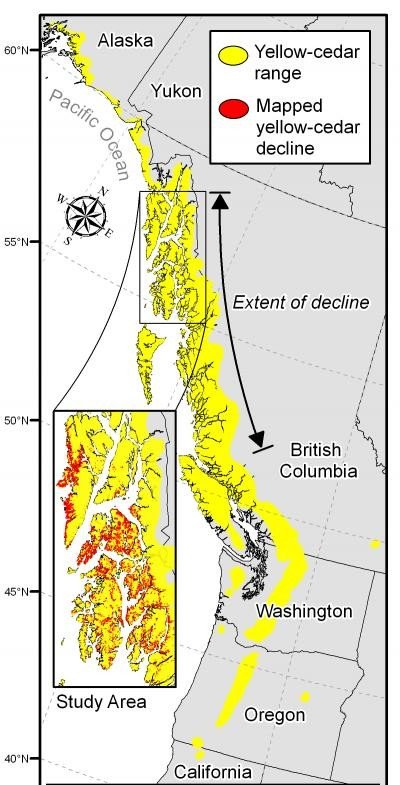Yellow-cedar can be found growing from California to Prince William Sound in Alaska. The yellow-cedar decline occurs along a 600-mile zone from British Columbia to southeast Alaska. Credit: Colin Shanley, The Nature Conservancy
PORTLAND, Ore., Feb. 2 (UPI) -- Yellow cedars, a culturally and economically valuable tree in Alaska and British Columbia, have been dying off because of shifting climate, researchers say.
The die-offs have affected about 60 percent to 70 percent of trees in forests covering 600,000 acres in the region, researchers say, and it's all down to snow -- or more accurately the lack of it.
"The cause of tree death, called yellow-cedar decline, is now known to be a form of root freezing that occurs during cold weather in late winter and early spring, but only when snow is not present on the ground," U.S. Department of Agriculture scientist Paul Hennon said.
"When present, snow protects the fine, shallow roots from extreme soil temperatures. The shallow rooting of yellow-cedar, early spring growth, and its unique vulnerability to freezing injury also contribute to this problem," Hennon, who works in the USDA's Pacific Northwest Research Station, said in a department release Wednesday.
Yellow cedars thrive in wet soils, but their tendency to produce shallow roots to access nitrogen on these sites makes them more vulnerable when spring snow levels are reduced by climate warming, researchers said.
The slow-growing trees -- many are 700 to 1,200 years old -- are culturally significant to Native Alaskans who use them to make paddles, masks, dishes and woven items, and are valuable commercially for home and boat building because of their wood's straight grain.















